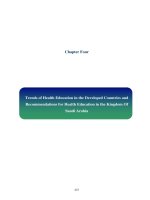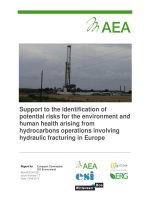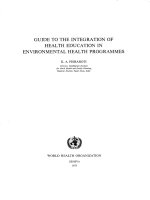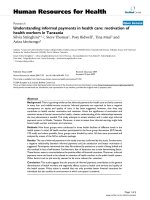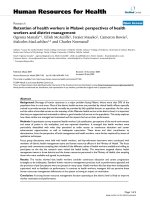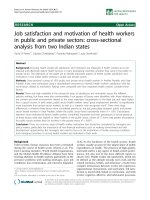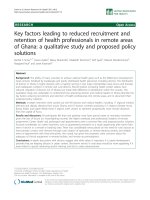EVALUATION OF HEALTH RISKS IN THE WASTEWATER RECLAMATION IN THE ABUKUMA WATERSHED, JAPAN
Bạn đang xem bản rút gọn của tài liệu. Xem và tải ngay bản đầy đủ của tài liệu tại đây (204.89 KB, 11 trang )
Journal of Water and Environment Technology, Vol.3, No.2, 2005
EVALUATION OF HEALTH RISKS IN THE WASTEWATER RECLAMATION IN THE ABUKUMA
WATERSHED, JAPAN
T. Watanabe*, K. Hashimoto*, Y. Abe* and T. Omura*
*Department of Civil Engineering, Graduate School of Engineering, Tohoku University, Aoba-yama 06,
Sendai 980-8579, Japan
Email:
ABSTRACT
Wastewater reclamation is an effective countermeasure to water shortage. However, there is a concern that wastewater
reclamation causes health risks of infection by pathogens and cancer by disinfection by-products such as trihalomethanes
(THMs). To discuss these risks, the Disability-Adjusted Life Years (DALY) has been employed and integrated with the unit
of lost lifetime. Health risks such as infection and cancer in Fukushima city with population of 0.3 millions were evaluated
using the DALY in the wastewater reclamation as a drinking water source. The damage [%•day] from the shortage of water
was quantified using the product of the percentage deficiency to water supply demand [%] and the period of deficiency
[days]. In the current situation of water utilization without reclamation, the DALY for total population was about 11 years.
Reclamation of secondary effluent without disinfection brought no increase of DALY when the damage between 0 and
300 %•day was reduced. On the other hand, the DALY drastically increased when the reduction of the damage was over
300 %•days. If the secondary effluent was disinfected with chlorine, the maximum damage of 1200 %•day could be reduced
by its reclamation without any increase of DALY.
KEYWORDS
Disability-Adjusted Life Years (DALY), health risks, wastewater reclamation
INTRODUCTION
Water shortage is recognized as one of the most serious problems in the global environment. The United
Nations (UN) reported in 1995 one third of the world population suffered from water shortage and in
2025 two thirds of the population is expected to experience the same problem due to the increase of
water demand. To solve the problem, the wastewater reclamation has been introduced into water
utilization system for the purposes of toilet flushing, car washing and irrigation in urbanized area. In
Singapore, wastewater treated with membrane technologies has been provided as the drinking water
- 223 -
Journal of Water and Environment Technology, Vol.3, No.2, 2005
known as “Newater”. If water shortage becomes a more serious problem, wastewater reclamation as a
source of drinking water will be popular in the future.
Since pathogens are often detected from secondary effluent (Omura et al., 1989; Havelaar et al., 1993;
Yano et al., 1993), appropriate disinfection of the effluent is necessary before reclamation to prevent the
increase of the infectious risk. Watanabe et al. (2003) concluded that infectious risk caused by poliovirus
1 did not increase in reclaiming the secondary effluent disinfected with chlorine as a part of the drinking
water source. However, well-known carcinogenic substances such as trihalomethanes (THMs) are
produced when the secondary effluent is disinfected with chlorine. Therefore, cancer risk as well as
infectious risk in wastewater reclamation should be evaluated and decreased to acceptable level.
The objective of this study is to evaluate both the health risks of infection and cancer in the wastewater
reclamation using the health index of the Disability-Adjusted Life Years (DALY). The DALY was
developed by Murray and Lopez (1996) for the investigation on Global Burden of Disease (GBD) with
World Health Organization (WHO). This index has the advantage to quantify the burden for population,
which is evaluated from fatal diseases such as cancer and nonfatal diseases such as infectious diseases in
the same unit of the lost lifetime [years]. Lifetime lost by nonfatal diseases is determined according to
the disability caused by the diseases.
MATERIALS AND METHODS
Wastewater reclamation
Prediction of the river discharge at the intake point. The wastewater reclamation is simulated in
Fukushima city located at the middle reach of the Abukuma river in Japan. In this city with the
population of 0.3 million, the Abukuma river is used as a drinking water source. Fukushima city often
suffer from water shortage caused by low discharges of the Abukuma river, especially during the
summer season. In order to predict the shortage of water in this city, Watanabe et al. (2003) categorized
the river discharge observed from 1980 to 1999 at the intake point of the water treatment plant into 20
levels and derived the matrix of simultaneous probability of discharge levels on consecutive two days
from the categorized data. With the derived matrix of probability, they proposed a method to predict the
shortage of water by reproducing the river discharge level at the intake point day by day. In this study,
the shortage of water in Fukushima city is predicted with this method sufficiently validated for its
rationality (Watanabe et al., 2003).
Scenarios on the wastewater reclamation. The wastewater is reclaimed as a part of drinking water
source. The daily dosage of the drinking water is assumed to be 2 L for all individuals in Fukushima city.
According to statistical analysis of river discharge at the intake point by the Ministry of Land,
- 224 -
Journal of Water and Environment Technology, Vol.3, No.2, 2005
Infrastructure and Transportation in Japan, discharge below 25 m3/s is very rare. Therefore, this situation
is regarded as the shortage of water. In such case, the intake from the Abukuma river is restricted by the
river discharge level (Watanabe et al., 2003), and the wastewater is reclaimed as a drinking water source
in two scenarios A-1 and A-2. In scenario A-1, the wastewater reclamation covers half of the shortage of
drinking water source. In scenario A-2, all of the shortage of water is replaced by the reclaimed
wastewater.
Damage from the shortage of water. The damage [%•day] from the shortage of water is quantified by the
product of the percent of deficiency to the water supply demand [%] and the period of deficiency [days]
(Ikebuchi, 2001).
Evaluation of the infectious risk
Pathogen and dose-response model. Rotavirus is employed for the evaluation of infectious risk in the
wastewater reclamation. The infectious risk caused by rotavirus is evaluated with dose-response model
proposed by Rose and Gerba (1991).
Assumptions for the evaluation of infectious risk. The concentration of rotavirus is assumed to be 50,000
times lower than that of total coliforms (Kaneko, 1997). The concentration of total coliforms in the river
is predicted based on the river discharge with the matrix of probability (Watanabe et al., 2003). Infected
persons excrete rotavirus at the concentration of 106 PFU/g of feces for 30 days (Kaneko, 1997). The
concentration of rotavirus in the wastewater is calculated from the number of infected persons and the
discharge volume of wastewater (360 L/d/person). Ninety percents of rotavirus in the wastewater are
removed by primary and secondary wastewater treatments (Kaneko, 1997). Moreover, 99.9% of
rotavirus in the secondary effluent is inactivated by the chlorine disinfection (Vaughn et al., 1986). The
viral concentration in the drinking water source is calculated from those in the reclaimed wastewater and
the river water. The removal efficiency of rotavirus by the conventional water treatment ranges from 1.7
to 2.9 log (Watanabe et al., 2003). The inactivation efficiency of rotavirus in the drinking water by the
chlorine disinfection after the water treatment is assumed to be 3log (Vaughn et al., 1986).
Relative sensitivity to the infection. Figure 1 shows the relative sensitivity of Japanese to intestinal
infectious diseases caused by pathogens including rotavirus (Watanabe et al., 1999). The sensitivity for
Japanese infants and children between 0 and 4 years old is higher than those on any other age groups.
The sensitivity is considered in the evaluation of infectious risk with the reliable method proposed by
Watanabe et al. (1999).
- 225 -
Journal of Water and Environment Technology, Vol.3, No.2, 2005
Relative sensitivity
55
44
33
22
11
00
0~4歳
0-4
5~14
15~44
45~64
5-14 15-44 45-64
年齢階級
65以上
?65
Age
Figure 1. Relative sensitivity to intestinal
infectious diseases for Japanese.
Evaluation of the cancer risk
Assumptions for the evaluation of cancer risk. Trihalomethanes (THMs) consisting of chloroform,
bromodichloromethane (BDCM), dibromochloromethane (DBCM) and bromoform are employed as
disinfection by-products causing cancer risk. Since it is known that THMs causes cancer in liver, the risk
for the liver cancer is evaluated. The concentrations of THMs in the drinking water are calculated from
THMs production capacities in the reclaimed wastewater and the river water. When the secondary
effluent without disinfection in the wastewater treatment is reclaimed, the THMs production capacity in
the reclaimed wastewater is 333.0 µg/L (Table 1). On the other hand, if the reclaimed secondary effluent
is disinfected in the wastewater treatment, the THMs production capacity is assumed to be 113.8 µg/L
considering the volatilization of THMs during the storage of the wastewater before its reclamation. The
THMs production capacity in the river water is determined using the Monte Carlo method based on the
observed data which is well-expressed by the lognormal distribution with the average of 107 µg/L.
Moreover, it is assumed that 30% of the THMs production capacity is reduced in the conventional water
treatment process (Tambo, 1983).
Table 1. THMs production capacity in the secondary effluent [µg/L].
Chloroform
With volatilization
Without volatilization
BDCM
47.1
112.7
37.5
131.0
DBCM Bromoform Total THMs
24.1
5.1
113.8
74.3
15.1
333.0
Calculation of cancer risk. According to the Integrated Risk Information System (IRIS) published online
by the U.S. EPA, cancer risks for lifetime exposure (70 years) to THMs except chloroform can be
evaluated from the concentration in the drinking water with the slope factor. In case of chloroform, the
- 226 -
Journal of Water and Environment Technology, Vol.3, No.2, 2005
U.S.EPA estimated the reference dose of 0.01mg/kg/d as a daily exposure that is likely to be without an
appreciable risk of deleterious effects during a lifetime. If the person with the weight of 50 kg drinks 2 L
of water every day, the concentration in the drinking water should be lower than 0.25mg/L. The cancer
risk for chloroform is evaluated on the basis of the occurrence probability of the concentration higher
than 0.25mg/L.
Relative sensitivity to liver cancer. Figure 2 shows the relative sensitivity to liver cancer for each age
group. This sensitivity is calculated on the basis of the cases of liver cancer reported by Ministry of
Health, Labor and Welfare in Japan. Unlike the sensitivity to the infection (Figure 1), older people have
higher sensitivity to liver cancer. This sensitivity is considered in the evaluation of cancer risk in the
same manner as the evaluation of infectious risk.
44
33
22
11
00
0~4歳
0-4
5~9
5-9
10~14
10-14
15~19
15-19
20~24
20-24
25~29
25-29
30~34
30-34
35~39
35-39
40~44
40-44
45~49
45-49
50~54
50-54
55~59
55-59
60~64
60-64
65~69
65-69
70~74
70-74
75~79
75-79
80~84
80-84
85以上
?85
Relative sensitivity
55
年齢階級
Age
Figure 2. Relative sensitivity to liver cancer
for Japanese.
Evaluation of health risks by the DALY
What is DALY? The Disability-Adjusted Life Years (DALY) is the sum of the Years of Life Lost (YLL)
and the Years Lived with a Disability (YLD). The YLL indicating the lifetime lost by the fatal disease
can be calculated based on the life expectancy reported by Ministry of Health, Labor and Welfare in
Japan. The disability caused by fatal or nonfatal disease is quantified using the YLD by decreasing the
lifetime according to its severity as proposed by Murrey and Lopez (1996).
Calculation of the DALY based on the infectious risk. It was reported by Gerba et al. (1996) that 60% of
persons infected by rotavirus would be asymptomatic. The DALY is calculated only for symptomatic
persons. Since Gerba et al. (1996) proposed 0.01% as the fatality ratio for rotavirus infection, the YYL
for the infection is negligible. Symptomatic persons will suffer from diarrhea for seven days (Gerba et
al., 1996). Since the duration of disability is lower than that of cancer, both the time discounting rate and
- 227 -
Journal of Water and Environment Technology, Vol.3, No.2, 2005
the age-weighting factor were not considered in the calculation of YLD. The number of symptomatic
persons in an age group is calculated as the product of three valuables of the infectious risk, the relative
sensitivity to intestinal infectious disease (Figure 1) and the population in the age group. The DALY lost
by rotavirus infection is calculated by multiplying the YLD and total number of symptomatic persons.
Calculation of the DALY based on the cancer risk. The fatality rate for liver cancer was estimated as
84% from numbers of patients and deaths reported by the Ministry of Health, Labor and Welfare in
Japan. Based on this fatality rate and the survival data observed in a Japanese hospital, the death rate (Pi)
for liver cancer in the ith year after the medical treatment is calculated as shown in Figure 3. When the
symptoms of liver cancer develops, the medical treatment is performed at the age of a, and then the
expectation of DALY (DALYa) lost by liver cancer for the individual (Figure 4) is calculated using the
formula:
DALYa = ∑ Pi (YLLi + YLD i )
(1)
i
where, YLLi is the YLL for death at the age of a+i and YLDi is the YLD during i years. The DALY lost
by the liver cancer for the population is obtained by summing up the products of four valuables of the
cancer risk, the relative sensitivity to liver cancer (Figure 2), the population and DALYa for all age
40
40
16
16
14
14
30
30
12
12
10
10
DALYa
8
8
6
6
20
20
10
10
4
4
2
2
0
0
1
1
11
11
21
21
31
31
0-4
5~9
5-9
10~14
10-14
15~19
15-19
20~24
20-24
25~29
25-29
30~34
30-34
35~39
35-39
40~44
40-44
45~49
45-49
50~54
50-54
55~59
55-59
60~64
60-64
65~69
65-69
70~74
70-74
75~79
75-79
80~84
80-84
85歳以上
?85
0
0
0~4歳
Death rate in the ith year: Pi [%]
groups.
41
41
発病後の経過年数:i [年
Time elapsed since the medical treatment: i [yrs]
Figure 3. Death rate in the ith year after the
medical treatment for liver cancer.
年齢階級
Age
Figure 4. Expectation of DALY (DALYa) lost
by liver cancer for the individual.
RESULTS AND DISCUSSIONS
Health risks of infection and cancer in the wastewater reclamation
Infectious risk in the wastewater reclamation. Figure 5(a) shows the annual infectious risk in reclaiming
the secondary effluent without disinfection. When the secondary effluent was not reclaimed, that is in
the current situation of water utilization, the infectious risk ranged from 6.0 x 10-3 to 1.0 x 10-2. This
- 228 -
Journal of Water and Environment Technology, Vol.3, No.2, 2005
infectious risk is higher than that (about 1.0 x 10-3) generally reported (Kaneko, 1996). One of the
reasons for this high risk is that the actual dosage of drinking water may be lower than 2L. Another
reason is that rotavirus has the higher capacity of infection than any other viruses (e.g., poliovirus,
coksackie virus, adenovirus). When the reduced damage from the shortage of water was over 200%•day,
the infectious risk drastically increased. If the reduced damage was over 1000%•day, almost all
individuals was infected by rotavirus. Figure 5(b) shows the annual infectious risk in reclaiming the
disinfected secondary effluent. In this case, the infectious risk did not increase regardless of the reduced
damage from the shortage of water. It became obvious that the reclamation of the secondary effluent
disinfected with chlorine brought no increase of infectious risk caused by rotavirus.
100
Annual infectious risk
Annual infectious risk
100
10-1
10-2
10-3
No reclamation
Scenario A-1
Scenario A-2
0
200
400
600
800
No reclamation
Scenario A-1
Scenario A-2
10-1
10-2
10-3
0
1000 1200
Reduced damage from the shortage of water [%•day]
200
400
600
800
1000 1200
Reduced damage from the shortage of water [%•day]
(a) Case of reclaiming the secondary
effluent without disinfection
(b) Case of reclaiming the disinfected
secondary effluent
Figure 5. Relationship between the annual infectious risk caused by rotavirus and the
reduced damage from the shortage of water in the wastewater reclamation.
Annual risk of cancer
10-4
10-5
No reclamation
Scenario A-1
Scenario A-2
10-6
10-7
0
200
400
600
800
1000 1200
Reduced damage from the shortage of water [%•day]
Figure 6. Relationship between the annual risk of liver cancer caused by chloroform and the
reduced damage from the shortage of water in reclaiming the disinfected secondary effluent.
Cancer risk in the wastewater reclamation. Figure 6 illustrates the annual risk of cancer caused by
chloroform in reclaiming the disinfected secondary effluent. Cancer risk was almost constant regardless
- 229 -
Journal of Water and Environment Technology, Vol.3, No.2, 2005
of the reduced damage from the shortage of water. Annual cancer risks caused by other THMs were also
constant. The average risk of cancer caused by chloroform (3.2 x 10-6) was higher than those in other
three substances (BDCM: 6.3 x 10-7, DBCM: 6.8 x 10-7, bromoform: 7.7 x 10-8). When the secondary
effluent without disinfection was reclaimed, the cancer risk was almost the same as that shown in Figure
6.
Evaluation of the wastewater reclamation with the DALY
DALY lost by rotavirus infection. Figure 7(a) shows the DALY lost by rotavirus infection for the total
population (0.3 million) when the secondary effluent without disinfection was reclaimed. The maximum
DALY for total population was 194 years. In this case, The DALY for each individual was estimated as 5
hours and 40 minutes. In the case of no reclamation, DALYs for the total population and each individual
were 1.7 years and 3 minutes, respectively. Therefore, more than 190 years of lifetime in Fukushima city
will be lost by the wastewater reclamation. Figure 7(b) shows the DALY lost by rotavirus infection for
the total population in reclaiming the disinfected secondary effluent. The DALY in this case was the
200
150
100
No reclamation
Scenario A-1
Scenario A-2
50
0
0
200
400
600
800
1000 1200
DALY lost by rotavirus infection [yrs]
same as in case of no reclamation.
15
No reclamation
Scenario A-1
Scenario A-2
10
5
0
Reduced damage from the shortage of water [%•day]
(a) Case of reclaiming the secondary
effluent without disinfection
0
200
400
600
800
1000 1200
Reduced damage from the shortage of water [%•day]
(b) Case of reclaiming the disinfected
secondary effluent
Figure 7. Relationship between the DALY lost by rotavirus infection for total population
and the reduced damage from the shortage of water in the wastewater reclamation.
DALY lost by cancer. Figure 8 illustrates the DALY lost by liver cancer in reclaiming the disinfected
secondary effluent. Since cancer risk did not increase in the wastewater reclamation as shown in Figure
6, the DALY lost by liver cancer was also constant (9.2 years). Similar result was obtained in the case of
reclaiming the secondary effluent without disinfection.
Comparison of the DALY lost by infection with that lost by cancer. Figure 9(a) illustrates the comparison
- 230 -
Journal of Water and Environment Technology, Vol.3, No.2, 2005
of the DALY lost by rotavirus infection with that lost by liver cancer for the total population in
reclaiming the secondary effluent without disinfection. The sum of these two DALYs is also illustrated
in this figure. When the damage from the shortage of water between 0 and 300%•day was reduced, the
sum of DALYs was constant (about 11 years). On the other hand, if the reduced damage was over
300%・day, the sum was drastically increased corresponding to the increase of DALY lost by infection.
Figure 9(b) shows DALYs lost by cancer and infection in reclaiming the disinfected secondary effluent.
In this case, the maximum damage of 1200 %•day could be reduced by reclamation without any increase
of DALY. Therefore, if 99.9% of rotavirus in the secondary effluent is inactivated by chlorine
disinfection, the same health risks in the current situation of the water utilization could be maintained in
DALY lost by liver cancer [yrs]
the wastewater reclamation from the viewpoint of DALY.
No reclamation
Scenario A-1
Scenario A-2
0
200
400
600
800
1000 1200
Reduced damage from the shortage of water [%•day]
Figure 8. Relationship between the DALY lost by liver cancer for total population and the
reduced damage from the shortage of water in reclaiming the disinfected secondary effluent.
250
Infection
Cancer
Total
80
DALY [yrs]
200
DALY [yrs]
100
Infection
Cancer
Total
150
100
50
60
40
20
0
0
0
200
400
600
800
1000 1200
Reduced damage from the shortage of water [%•day]
(a) Case of reclaiming the secondary
effluent without disinfection
0
200
400
600
800
1000 1200
Reduced damage from the shortage of water [%•day]
(b) Case of reclaiming the disinfected
secondary effluent
Figure 9. Comparison of the DALY lost by rotavirus infection with that lost by
liver cancer for total population in the wastewater reclamation.
- 231 -
Journal of Water and Environment Technology, Vol.3, No.2, 2005
CONCLUSIONS
Health risks such as liver cancer and rotavirus infection caused by the wastewater reclamation as a
drinking water source in Fukushima city with 0.3 million population were evaluated. The shortage of
water was predicted using the matrix of simultaneous probability of river discharge levels on two
consecutive days at the intake point of the water treatment plant. DALYs lost by cancer and infection
were calculated from the evaluated risks. The following conclusions were obtained:
1) In the current situation of water utilization without reclamation, DALYs lost by cancer and infections
in the city were 9.2 and 1.7 years, respectively.
2) When the damage between 0 and 300 %•day was reduced, the reclamation of the secondary effluent
without disinfection brought no increase of DALY. On the other hand, the DALY drastically increased
when the reduction of the damage was over 300 %•day.
3) If 99.9% of rotavirus in the secondary effluent was inactivated by chlorine disinfection, the damage
from the shortage of water could be reduced by its reclamation without any increase of DALY.
4) Health risk evaluation based on DALY would contribute to policy making for the introduction of the
wastewater reclamation into the water utilization system in the watershed.
ACKNOWLEDGEMENT
This study was partially supported by Ministry of Education, Culture, Sports, Science and Technology
(MEXT) in the project of Symbiosis of Human, Nature and the Earth under Research Revolution 2002
(RR2002) and Japan Society for the Promotion of Science (JSPS), Grand-in-Aid for Young Scientists
(B), 2004-2005 (Project No.: 16760439).
REFERENCES
Gerba, C. P., Rose, J. B., Haas, C. N. and Crabtree, K. D. (1996). Waterborne rotavirus: A risk
assessment. Wat. Res., Vol.30, No.12, 2929-2940.
Havelaar, A. H. (1993). F-specific RNA Bacteriophages Are Adequate Model Organisms for Viruses in
Fresh Water. Applied Environ. Microbiol., Vol.59, 2956-2962.
Ikebuchi, S. (2001). Water Resource Engineering. Morikita Publishing Co., Ltd., Japan (in Japanese).
Kaneko, M. (1996). Water Quality and Hygiene. Gihoudo Shuppan Co., Ltd., Japan (in Japanese)
Kaneko, M. (1997). Disinfection of Water. Japan Education Center of Environmental Sanitation, Japan
(in Japanese).
Murray, C. J. L. and A. D. Lopez (1996). THE GLOBAL BURDEN OF DISEASE, Harvard Univ. Press,
UK.
Omura, T., Onuma, M., Aizawa, J., Umita, T. and Yagi, T. (1989). Removal Efficiencies of Indicator
Micro-Organisms in Sewage Treatment Plants. Wat. Sci. and Tech., Vol.21, No.3, 119-124.
- 232 -
Journal of Water and Environment Technology, Vol.3, No.2, 2005
Rose, J. B. and Gerba, C. P. (1991). Use of risk assessment for development of microbial standards. Wat.
Sci. and Tech., Vol.24, No.2, 29-34.
Tambo, N. (1983). Water supply and trihalomethanes, Gihoudo Shuppan Co., Ltd., Japan (in Japanese).
U.S.EPA. Integrated Risk Information System (on the web, />Vaughn, J. M., Chen, Y.-S., Thomas, M. Z. (1986). Inactivation of human and simian rotaviruses by
chlorine. Applied Environ. Microbiol., Vol.51, 391-394.
Watanabe, T., Fukushi, K. and Omura, T. (1999). Risk assessment for waterborne disease by poliovirus
in city through drinking water, Preprint of 7th IAWQ Asia-Pacific Regional Conference, 370-375.
Watanabe, T., Hashimoto, K., Abe, Y. and Omura, T. (2003). Risk Evaluation of Pathogens in Wastewater
Reclamation as a Drinking Water Source. Proceedings of the 76th Annual Meeting Technical Exhibition
and Conference (WEFTEC®2003), CD-ROM.
Yano, K., Yoshida, Y., Shinkai, T. and Kaneko, M. (1993). A Practical Method for the Concentration of
Viruses from Water Using Fibriform Cellulose and Organic Coagulant. Wat. Sci. and Tech., Vol.27,
No.3-4, 295-298.
- 233 -


